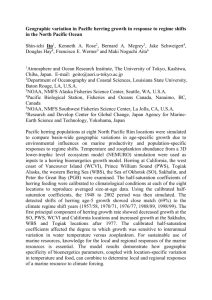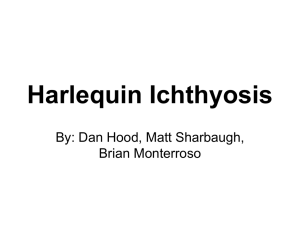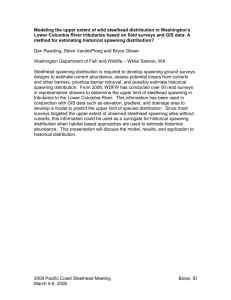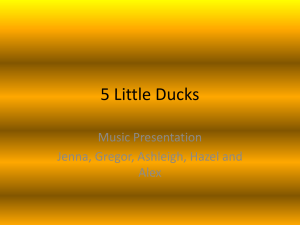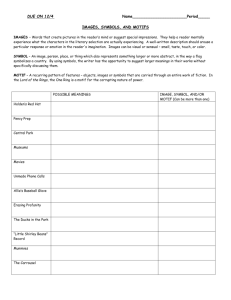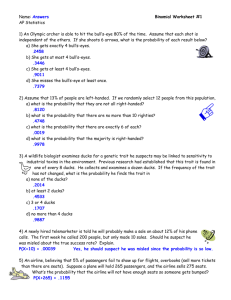Nutrient acquisition by female Harlequin Ducks evidence for body mass optimization
advertisement
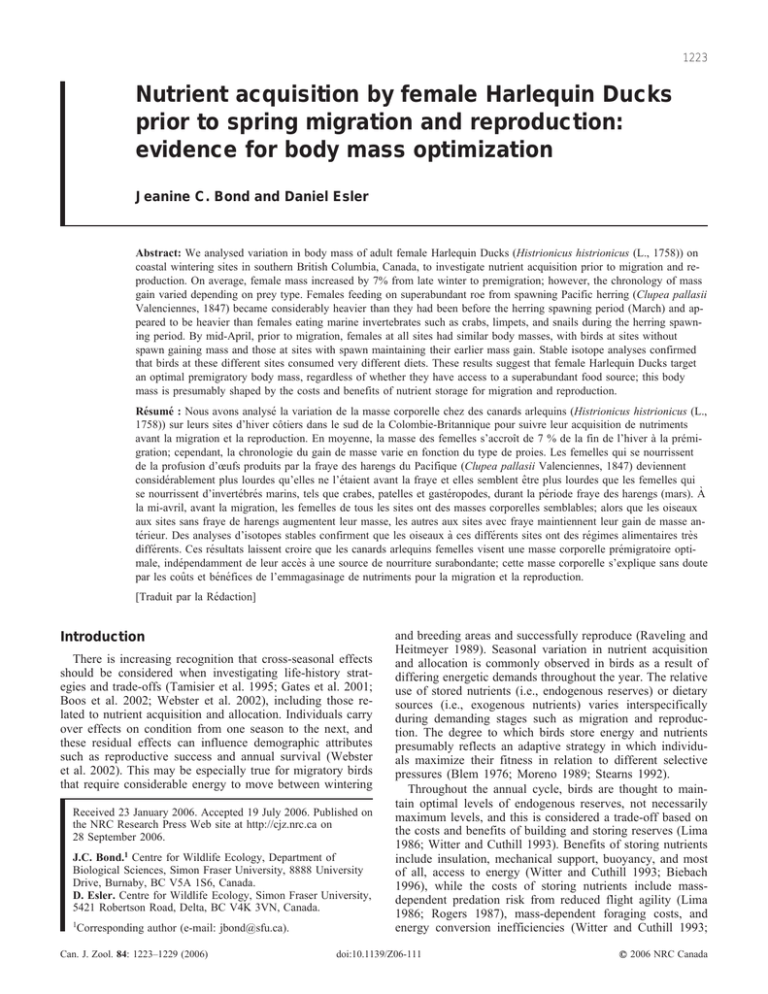
1223 Nutrient acquisition by female Harlequin Ducks prior to spring migration and reproduction: evidence for body mass optimization Jeanine C. Bond and Daniel Esler Abstract: We analysed variation in body mass of adult female Harlequin Ducks (Histrionicus histrionicus (L., 1758)) on coastal wintering sites in southern British Columbia, Canada, to investigate nutrient acquisition prior to migration and reproduction. On average, female mass increased by 7% from late winter to premigration; however, the chronology of mass gain varied depending on prey type. Females feeding on superabundant roe from spawning Pacific herring (Clupea pallasii Valenciennes, 1847) became considerably heavier than they had been before the herring spawning period (March) and appeared to be heavier than females eating marine invertebrates such as crabs, limpets, and snails during the herring spawning period. By mid-April, prior to migration, females at all sites had similar body masses, with birds at sites without spawn gaining mass and those at sites with spawn maintaining their earlier mass gain. Stable isotope analyses confirmed that birds at these different sites consumed very different diets. These results suggest that female Harlequin Ducks target an optimal premigratory body mass, regardless of whether they have access to a superabundant food source; this body mass is presumably shaped by the costs and benefits of nutrient storage for migration and reproduction. Résumé : Nous avons analysé la variation de la masse corporelle chez des canards arlequins (Histrionicus histrionicus (L., 1758)) sur leurs sites d’hiver côtiers dans le sud de la Colombie-Britannique pour suivre leur acquisition de nutriments avant la migration et la reproduction. En moyenne, la masse des femelles s’accroı̂t de 7 % de la fin de l’hiver à la prémigration; cependant, la chronologie du gain de masse varie en fonction du type de proies. Les femelles qui se nourrissent de la profusion d’œufs produits par la fraye des harengs du Pacifique (Clupea pallasii Valenciennes, 1847) deviennent considérablement plus lourdes qu’elles ne l’étaient avant la fraye et elles semblent être plus lourdes que les femelles qui se nourrissent d’invertébrés marins, tels que crabes, patelles et gastéropodes, durant la période fraye des harengs (mars). À la mi-avril, avant la migration, les femelles de tous les sites ont des masses corporelles semblables; alors que les oiseaux aux sites sans fraye de harengs augmentent leur masse, les autres aux sites avec fraye maintiennent leur gain de masse antérieur. Des analyses d’isotopes stables confirment que les oiseaux à ces différents sites ont des régimes alimentaires très différents. Ces résultats laissent croire que les canards arlequins femelles visent une masse corporelle prémigratoire optimale, indépendamment de leur accès à une source de nourriture surabondante; cette masse corporelle s’explique sans doute par les coûts et bénéfices de l’emmagasinage de nutriments pour la migration et la reproduction. [Traduit par la Rédaction] Introduction There is increasing recognition that cross-seasonal effects should be considered when investigating life-history strategies and trade-offs (Tamisier et al. 1995; Gates et al. 2001; Boos et al. 2002; Webster et al. 2002), including those related to nutrient acquisition and allocation. Individuals carry over effects on condition from one season to the next, and these residual effects can influence demographic attributes such as reproductive success and annual survival (Webster et al. 2002). This may be especially true for migratory birds that require considerable energy to move between wintering Received 23 January 2006. Accepted 19 July 2006. Published on the NRC Research Press Web site at http://cjz.nrc.ca on 28 September 2006. J.C. Bond.1 Centre for Wildlife Ecology, Department of Biological Sciences, Simon Fraser University, 8888 University Drive, Burnaby, BC V5A 1S6, Canada. D. Esler. Centre for Wildlife Ecology, Simon Fraser University, 5421 Robertson Road, Delta, BC V4K 3VN, Canada. 1Corresponding author (e-mail: jbond@sfu.ca). Can. J. Zool. 84: 1223–1229 (2006) and breeding areas and successfully reproduce (Raveling and Heitmeyer 1989). Seasonal variation in nutrient acquisition and allocation is commonly observed in birds as a result of differing energetic demands throughout the year. The relative use of stored nutrients (i.e., endogenous reserves) or dietary sources (i.e., exogenous nutrients) varies interspecifically during demanding stages such as migration and reproduction. The degree to which birds store energy and nutrients presumably reflects an adaptive strategy in which individuals maximize their fitness in relation to different selective pressures (Blem 1976; Moreno 1989; Stearns 1992). Throughout the annual cycle, birds are thought to maintain optimal levels of endogenous reserves, not necessarily maximum levels, and this is considered a trade-off based on the costs and benefits of building and storing reserves (Lima 1986; Witter and Cuthill 1993). Benefits of storing nutrients include insulation, mechanical support, buoyancy, and most of all, access to energy (Witter and Cuthill 1993; Biebach 1996), while the costs of storing nutrients include massdependent predation risk from reduced flight agility (Lima 1986; Rogers 1987), mass-dependent foraging costs, and energy conversion inefficiencies (Witter and Cuthill 1993; doi:10.1139/Z06-111 # 2006 NRC Canada 1224 Jönsson 1997). Decisions on how to balance these costs and benefits are further influenced by the environment in which the species resides, where predictability and accessibility of exogenous food sources may reduce the need for endogenous stores (Jönsson 1997). In waterfowl, strategies of nutrient acquisition for meeting costs of migration and reproduction differ spatially and temporally among species. For example, McLandress and Raveling (1981) found that Giant Canada Geese (Branta canadensis maxima L., 1758) undergo considerable fattening before they leave wintering sites, while Gauthier et al. (1992) determined that Greater Snow Geese (Chen caerulescens atlantica L., 1758) store nutrients while on spring staging areas. Other species such as Wood Ducks (Aix sponsa (L., 1758); Drobney 1982), Ruddy Ducks (Oxyura jamaicensis (J.F. Gmelin, 1789); Tome 1984), and Greater Scaup (Aythya marila (L., 1761); Gorman 2005) appear to store nutrients after arrival on nesting areas. The extent to which Harlequin Ducks (Histrionicus histrionicus (L., 1758)) build and use endogenous stores for migration and reproduction is unknown. If Harlequin Ducks store endogenous reserves for migration and subsequent investment in reproduction, it is important to determine where and when they build these nutrient stores to understand their nutrient acquisition strategy and potential constraints to nutrient acquisition. Harlequin Ducks winter in marine environments and generally consume intertidal invertebrates such as snails, crabs, amphipods, and limpets. In spring, these ducks migrate to freshwater streams for nesting, where they consume freshwater invertebrates (Robertson and Goudie 1999). Pacific herring (Clupea pallasii Valenciennes, 1847) spawn is a key feature of the wintering habitat of Harlequin Ducks on the Pacific coast that could influence nutrient stores. For 3–4 weeks in late winter – early spring, herring roe is superabundant and some Harlequin Ducks are known to aggregate at herring spawning sites (Vermeer et al. 1997; Rodway et al. 2003). Rodway and Cooke (2002) determined that herring eggs are the principal prey for these aggregated ducks throughout the spawning period. The ecological implications of this food source have received little investigation, although there has been speculation about potential benefits to survival and (or) reproductive performance (Rodway et al. 2003; Žydelis and Esler 2005). To investigate the timing of nutrient storage in Harlequin Ducks, as well as the mediating effects of forage type, we measured body mass of captured adult female Harlequin Ducks in winter prior to spring migration. Although massbased measurements do not allow differentiation of body stores into various components, they do show changes in overall nutrient storage over time. Generally, lipids are considered the most efficient source of fuel for migration (Witter and Cuthill 1993; Jenni and Jenni-Eiermann 1998) and the most common nutrients stored for clutch formation (Ankney and Alisauskas 1991). We also used stable isotope analyses to document diets of individuals to appropriately interpret the body mass data. Our specific objectives were to determine (i) whether females store nutrients on the wintering grounds prior to migration and (ii) the relative difference in amount or chronology of nutrient storage between females on herring spawning sites and those on non-spawning sites. For a species of concern like the Harlequin Duck Can. J. Zool. Vol. 84, 2006 (Robertson and Goudie 1999; Smith et al. 2001), strategies of nutrient acquisition for migration and reproduction can have important implications for understanding factors limiting productivity and, subsequently, can have important population and habitat management ramifications. Methods Study locations and capture techniques To evaluate body mass variation in relation to timing and occurrence of herring spawning events, Harlequin Ducks were captured on marine wintering areas in the Strait of Georgia, British Columbia, at sites with and without spawn during three periods in 2004: prespawning (27 February to 5 March), midspawning (19–27 March), and postspawning (2– 11 April). The postspawning period preceded the departure of nearly all Harlequin Ducks from wintering areas, which peaks in late April. Capture locations were determined based on historical records of herring spawn occurrence (Fisheries and Oceans Canada 2004), and spawning events began in this region around 8 March 2004 and continued for several weeks. Herring spawning events occur mainly in intertidal locations and are conspicuous events where the water becomes milky white from milt. Locations of spawning events are not necessarily consistent between years but we attempted to set up our sites where spawning events were most likely and least likely to occur and where Harlequin Ducks occur in significant numbers, as indicated by Rodway et al. (2003). Capture sites with spawn included locations around Hornby Island (49831’N, 124842’W), Denman Island (49832’N, 124849’W), and Qualicum Bay (49824’N, 124838’W), while capture sites without spawn included locations around southeast Quadra Island (50812’N, 129815’W) and Williams Beach (49852’N, 125807’W). We used a floating mist-net capture method modified for inshore use (Kaiser et al. 1995). Harlequin Ducks are susceptible to capture by this method because they tend to fly low over intertidal areas. Captured birds were immediately removed from the net and then banded and weighed on an electronic balance (±1 g). We measured morphometric features including exposed culmen length and diagonal tarsal length to the nearest 0.01 mm, as well as wing chord (flattened and straightened) to the nearest millimetre. Age classes of females were determined by the depth of the bursa of Fabricius (Mather and Esler 1999), and all females included in further analyses were after third year (i.e., adults). The Simon Fraser University Animal Care Committee sanctioned the methods used in this study (animal care permit No. 668B-033). Sampling methods and laboratory techniques Some Harlequin Ducks move from their wintering site to herring spawning sites and then return to their original wintering site; because of this, we selected non-spawning sites at which few birds exhibited this movement (Rodway et al. 2003). However, to confirm that birds captured in nonspawning sites had not consumed herring roe, we used stable isotope analysis to evaluate recent prey composition. The isotope signatures of consumer tissues are related to the consumer’s diet (DeNiro and Epstein 1978), and therefore the stable isotope technique is ideal for identifying individ# 2006 NRC Canada Bond and Esler 1225 uals that consume different food types. The heavy isotope of nitrogen (15N) is preferentially incorporated into tissues of the consumer from the diet, which results in a systematic enrichment in the nitrogen stable isotope ratio with increases in trophic level (Kelly 2000). For this study, we expected herring roe to have a more enriched nitrogen stable isotope ratio than marine intertidal invertebrates eaten by wintering Harlequin Ducks, and we predicted that this difference would be reflected in the tissues of Harlequin Ducks consuming the different prey. We analysed female plasma rather than cellular blood because plasma indicates diet information over the short term, i.e., within a few days, whereas cellular blood may take up to a month to isotopically reflect a dietary change (Hobson and Clark 1992a, 1993; Bearhop et al. 2002). A 1.5 mL blood sample was taken from the jugular veins of captured females using a heparinized 5.0 mL syringe with a 21-gauge needle. For a small number of females, a 1.0 mL syringe with a 24-gauge needle was used to take 0.5 mL of blood from the tarsal vein instead. Collected blood was transferred to a heparinized vial and stored on ice until the plasma was separated from cellular blood components using a centrifuge (within 12 h). These samples were transferred to separate vials and stored frozen. Also, following information provided by Rodway and Cooke (2002), we collected intertidal crabs (Hemigrapsus spp.), snails (Littorina spp.), limpets (Collisella spp. and Notoacmea spp.), and amphipods as food items making up the majority of the winter diet of Harlequin Ducks, as well as herring roe for comparison. Samples for stable isotope analyses were prepared at Simon Fraser University and then sent to the Department of Soil Sciences at the University of Saskatchewan for isotope ratio determination. The samples analysed in this study included plasma and marine diet items. We analysed several plasma samples from each site during the different periods for a total of 48 samples. Plasma samples were dried in an oven at 60 8C and ground to a fine powder with a mortar and pestle. The marine diet samples were rinsed with distilled water, removed from shells (for limpets and snails), dried, and then powdered in the same fashion. Lipids were removed from the diet samples using a 2:1 chloroform:methanol solution (Bligh and Dyer 1959) and retrieved by evaporating off the solvent in a fume hood. The lipid-free, powdered invertebrate samples were treated with a few drops of 0.1 N HCl, without rinsing, to remove carbonates. The nitrogen stable isotope signatures of samples were determined by loading 1 mg of each sample into a tin cup and combusting it at 1200 8C in a Robo-Prep elemental analyzer. Isotope ratios were then measured in a Europa 20:20 mass spectrometer using continuous-flow isotope ratio mass spectrometry. Analytical error for nitrogen isotope measurements was estimated to be 0.3%. All isotope values per sample are expressed in delta (d) notation, a ratio of the heavier to the lighter isotope relative to a standard in parts per thousand. This ratio is calculated as follows: d15 N ¼ ðRsample =Rstandard 1Þ 1000 where R is the corresponding ratio for nitrogen is atmospheric nitrogen. 15N/14N. The standard Statistical methods We used general linear models to evaluate variation in body mass of adult female Harlequin Ducks on marine areas in relation to site status (spawning versus non-spawning), period (prespawning, midspawning, and postspawning), and body size. A principal component analysis was conducted to create an index of body size for each individual based on tarsus, wing chord, and culmen measurements. This index, the PC1 score, showed positive relationships with all morphometric variables and had an eigenvalue of 1.27, explaining 42.5% of the total original variance. PC1 was included in a subset of candidate models (described below) to consider effects of body size on body mass and, if necessary, account for size-related variation when evaluating effects of sites and periods. We employed an information-theoretic approach to model selection (Burnham and Anderson 2002), applying a set of biologically plausible combinations of explanatory variables as candidate models (Table 1). The models represent different ways of grouping site status and period combinations, which is somewhat analogous to a two-way ANOVA with pairwise post-tests in a hypothesis-testing statistical paradigm. We used the same model sets with and without PC1 to allow consideration of body size effects. Because our data set consisted of 80 females, Akaike’s information criterion for small sample sizes (AICc) was calculated for each model (Table 1), which indicates the fit of the model given the data and the set of models considered. We also calculated the difference in AICc between each model and the best-fitting model (AICc) as well as the AICc weight (AICcW) for each model, which conveys the relative support for the model in the candidate model set. Results Stable isotope results The mean (±SE) nitrogen stable isotope ratio (d value) for lipid-free herring roe was 14.8% ± 0.04% and that for lipidfree marine invertebrates was 9.8% ± 0.04%. We estimated expected plasma values based solely on herring roe diet and mixed marine invertebrate diet by taking an average value for each diet and accounting for changes in isotope signature between prey and duck body tissues (i.e., discrimination or fractionation factors). The discrimination factor between Harlequin Duck plasma and diet has not been experimentally determined, so we applied a value of +3.3% determined for carnivorous species (Peregrine Falcon (Falco peregrinus Tunstall, 1771), Hobson and Clark 1992b; Dunlin (Calidris alpina pacifica L., 1758), Evans-Ogden et al. 2004). There was not perfect correspondence between the measured plasma values and the predicted plasma values (Fig. 1). This may have been a result of the discrimination factor we used or because we did not sample every possible invertebrate prey type, nor did we know the proportions of different invertebrate prey in the diet. In addition, birds feeding primarily on herring spawn also may have consumed some marine invertebrates. Despite these uncertainties, clear patterns are evident in the data (Fig. 1). Plasma stable isotope ratios were similar for females at spawning and non-spawning sites prior to the occurrence of herring spawning. Once spawning commenced, stable isotope signatures changed at spawning sites, # 2006 NRC Canada 1226 Can. J. Zool. Vol. 84, 2006 Table 1. Candidate models describing variation in female Harlequin Duck (Histrionicus histrionicus) body mass in relation to period, site status, and a principal component score. Model Model Model Model Model Model Model Model Model Model Model Model Model Model Model Model Model Model Model rank 1 2 3 4 5 6 7 8 9 10 11 12 13 14 15 16 17 18 Candidate model structure preN = preS = midN, midS = postN = postS + PC1 preN = preS = midN, midS, postN = postS + PC1 preN = preS = midN = postN, midS = postS + PC1 preN = preS, midN = midS = postN = postS + PC1 preN = preS, midS = midN, postS = postN + PC1 preN, preS, midN, midS, postN, postS + PC1 preN = preS = midN = postN = postS, midS + PC1 preN = midN = postN, preS = midS = postS + PC1 preN = preS = midN, midS = postN = postS PC1 preN = preS = midN, midS, postN = postS preN = preS, midN = midS = postN = postS preN = preS, midS = midN, postS = postN preN, preS, midN, midS, postN, postS preN = preS = midN = postN, midS = postS preN = preS = midN = postN = postS, midS preN = preS = midN = midS = postN = postS preN = midN = postN, preS = midS = postS K 4 5 4 4 5 8 4 4 3 3 4 3 4 7 3 3 2 3 AICc 551.6 553.5 556.9 556.9 559.2 559.5 564.8 567.4 568.4 568.7 570.3 572.3 574.5 577.1 577.8 584.8 589.5 590.1 AICc 0.00 1.81 5.25 5.27 7.52 7.84 13.16 15.75 16.79 17.09 18.64 20.67 22.88 25.48 26.11 33.13 37.82 38.41 AICcW 0.628 0.253 0.046 0.045 0.015 0.012 0.001 0.000 0.000 0.000 0.000 0.000 0.000 0.000 0.000 0.000 0.000 0.000 Note: The periods are those before herring spawning (pre), during herring spawning (mid), and after herring spawning (post). Site status refers to herring spawning sites (S) and non-spawning sites (N), and the principal component (PC1) indexes body size. K is the number of parameters estimated in the model, AICc is Akaike’s information criterion corrected for small sample sizes, AICc is the difference in AICc between the model being considered and the best-fitting model, and AICcW is the AICc weight or model likelihood. Fig. 1. Plasma nitrogen stable isotope ratios of female Harlequin Ducks (Histrionicus histrionicus) captured on Pacific herring spawning sites and non-spawning sites during the three periods corresponding to before, during, and after spawning. The dotted line illustrates the expected plasma values based on consumption of herring roe and the dashed line illustrates the expected plasma values based on consumption of equal portions of several marine invertebrates (snails, crabs, amphipods, and limpets). Discrimination factors were applied to obtain expected plasma values (see text). 19 Spawning sites Non-spawning sites 18 16 15 δ N (‰) 17 15 14 13 12 Prespawning Midspawning Postspawning consistent with a switch to a more isotopically enriched diet, while isotope signatures at non-spawning sites did not change. Most importantly, there was no isotopic evidence that birds captured at non-spawning areas consumed spawn during any period; therefore, we are confident that our body mass data during this time period accurately represent birds consuming marine invertebrates. The isotope signatures for some females captured at spawning sites during the post- spawning period were decreasing, which presumably was a reflection of birds switching back to consuming marine invertebrates as herring roe became less available. Body mass analysis We captured and measured 80 adult female Harlequin Ducks on wintering sites and found that period, site status, and body size had important effects on body mass. From our candidate set of models evaluating mass variation, the model best supported by the data (model 1, Table 1) was that which indicated that body mass differed between the following two groups: (1) birds at both spawning and nonspawning sites during the prespawning period and those at non-spawning sites during the midspawning period and (2) birds at spawning sites during the midspawning period and those at both spawning and non-spawning sites during the postspawning period. An examination of the data (Fig. 2) supports this model structure. This model, which included the body size parameter, was strongly supported, with an AICcW of 0.628 and an R2 value of 0.41. The second best supported model (model 2) had a similar model structure, with the only difference being that data from the midspawning period at spawning sites were treated as a separate group; this model received less than half the support (AICcW = 0.253) of model 1. None of the remaining models received substantial support, including global models in which all periods and sites were treated as separate groups (models 6 and 14, with and without PC1, respectively) and null models in which all data were treated as one group (models 10 and 17, with and without PC1, respectively). These results strongly support the conclusions that body size explained important variation in the data and that body mass of females differed between prespawning and postspawning periods, but not between sites during those peri# 2006 NRC Canada Bond and Esler Fig. 2. Mass (mean ± SE) of adult female Harlequin Ducks on wintering sites with and without spawning Pacific herring during prespawning, midspawning, and postspawning periods in the Strait of Georgia, British Columbia. Sample sizes for each group are indicated in parentheses. ods. There was more uncertainty surrounding mass dynamics during the midspawning period, although the high AICcW for models 1 and 2 combined (summed AICcW = 0.881) supports the conclusion that masses differed between sites during midspawning. Also, models in which midspawning data from both sites were combined, either lumped with postspawning data (model 4) or alone (model 5), were not well supported (AICcW of 0.045 and 0.015, respectively). To summarize, our analysis provided support for the conclusions that body mass (after accounting for body size) of adult female Harlequin Ducks was similar between spawning and non-spawning sites prior to spawning, that females on spawning sites increased mass substantially during the midspawning period while those on non-spawning sites seemed to maintain their earlier mass, and that masses were similar between sites during the postspawning period owing to increases in mass of birds from non-spawning sites and maintenance of previously gained mass by birds from spawning sites. The change in average body mass (±SE) between prespawning and postspawning periods, for both sites, was 40 ± 10 g, an increase of 7% ± 1.8% (Fig. 2). Although sample size of females captured during midspawning on non-spawning sites was low, the data support the conclusion that the chronology of mass gain may depend on the prey consumed (i.e., herring roe or marine invertebrates), and this finding warrants further investigation. Discussion Like many waterfowl, adult female Harlequin Ducks store endogenous nutrients on wintering areas prior to spring migration. Our data indicate that despite dramatic differences in forage type and availability between herring spawning sites and non-spawning sites, females from both areas achieved a similar body mass prior to departure from wintering areas. This result suggests that females target an optimal premigratory body mass that balances the costs and benefits of nutrient storage, irrespective of exogenous nutrient availability. 1227 Nutrient acquisition and storage prior to migration and reproduction can have significant fitness benefits. Storing energy for migration is important for sustained flights and reduces the need for stopovers, which increases the speed of migration, and can buffer against food shortage in low-quality stopover sites (Biebach 1996). For reproduction, a growing body of evidence indicates that female waterfowl must attain some minimum level of nutrient reserves to initiate egg production (Drent and Daan 1980; Alisauskas and Ankney 1994; Esler et al. 2001; Gorman 2005). Hence, arrival on breeding areas with higher levels of energy and nutrients can allow females to attain this breeding threshold faster and therefore nest earlier (Schultz 1991; Alisauskas and Ankney 1992). Numerous studies demonstrate that earlier nesting results in higher reproductive success through larger clutch sizes, increased opportunities for renesting, and (or) more favourable environmental conditions for broods (Perrins 1966; Rowe et al. 1994; Lepage et al. 2000). These benefits of nutrient storage are countered by costs. Predation risk may be higher for heavier birds because of reduced maneuverability and ability to escape predators (Lima 1986; Rogers 1987). As well, heavier birds incur higher flight costs through increased wing loading, which is important for migrating birds (Kullberg et al. 2005). This may be especially important for ducks, which have relatively high wing loading. Also, for diving birds such as the Harlequin Duck, higher fat levels associated with increased mass could increase buoyancy and therefore increase costs of foraging (Witter and Cuthill 1993). In light of these potential costs, Harlequin Ducks likely face a trade-off against the potential benefits of nutrient storage. Our findings indicate that access to Pacific herring spawn may influence the chronology of nutrient storage but that it does not affect the absolute amount of nutrients acquired on wintering sites. Herring roe provides a superabundant food source on which Harlequin Ducks are known to aggregate and feed (Rodway and Cooke 2002; Rodway et al. 2003), and fish eggs are a high-energy, lipid-rich diet item (Paul and Paul 1999). However, because female Harlequin Ducks achieve the same premigratory body mass when feeding on intertidal invertebrates, we speculate that there may be benefits to aggregating on spawning sites beyond nutrient acquisition. These may include important social interactions, as suggested by Rodway et al. (2003), or an increase in the time spent in non-foraging behaviours owing to reductions in feeding time (Rodway and Cooke 2001; Žydelis and Esler 2005). Also, Rodway and Cooke (2001) suggested that Harlequin Ducks foraging on herring spawning sites would face less predation risk because they tend to move to safer offshore roosting sites earlier than birds foraging on invertebrates. Many other seabirds are known to aggregate and feed at herring spawning sites (Haegele 1993; Vermeer et al. 1997; Sullivan et al. 2002), and it is unknown how their mass dynamics are influenced by herring spawn. Some species that deplete winter foods, such as scoters (Melanitta spp.; Lacroix 2001), may rely more heavily on herring spawn for nutrient acquisition and hence may require spawn as a source of nutrients for spring hyperphagia. Also, high Arctic nesting species such as the Steller’s Eider (Polysticta stelleri (Pallas, 1769)) that aggregate on herring spawn prior to mi# 2006 NRC Canada 1228 gration (Žydelis and Esler 2005) may depend on this food source for breeding on potentially food-limited sites. The proportion of a population that aggregates on herring spawning sites may be indicative of the population’s dependence on spawn for meeting energetic costs (Vermeer et al. 1997), as illustrated by the fact that not all Harlequin Ducks in the Strait of Georgia aggregated during spawning events. Elucidating strategies for meeting the demands of migration and reproduction, including the role of herring spawn, is critical for informed management and conservation of bird species. As well, these strategies highlight the importance of considering cross-seasonal effects when managing populations. Acknowledgements We acknowledge the BC Hydro Bridge Coastal Restoration Program and Environment Canada’s Science Horizons Program for financial support and the Centre for Wildlife Ecology at Simon Fraser University for logistical support. For assistance in the field, we thank E. Anderson, J. Bond, K. Bond, J. Harding, J. Heath, S. Iverson, S. LeBourdais, E. McClaren, K. Wright, and R. Žydelis. T.D. Williams, R.C. Ydenberg, S.E. Jamieson, K. Martin, M. Heitmeyer, and an anonymous reviewer provided useful comments on earlier drafts. Also, T.D. Williams provided laboratory facilities at Simon Fraser University. Thanks to K.A. Hobson, P. Healy, M. Benjamin, and M. Stocki for assistance with stable isotope analysis. References Alisauskas, R.T., and Ankney, C.D. 1992. The cost of egg laying and its relationship to nutrient reserves in waterfowl. In Ecology and management of breeding waterfowl. Edited by B.D.J. Batt, A.D. Afton, M.G. Anderson, C.D. Ankney, D.H. Johnson, J.A. Kadlec, and G.L. Krapu. University of Minnesota Press, Minneapolis. pp. 30–61. Alisauskas, R.T., and Ankney, C.D. 1994. Nutrition of breeding female Ruddy Ducks: the role of nutrient reserves. Condor, 96: 878–897. Ankney, C.D., and Alisauskas, R.T. 1991. The use of nutrient reserves by breeding waterfowl. In Acta XX Congressus Internationalis Ornithologici. Edited by B.D. Bell. Christchurch, New Zealand. pp. 2170–2176. Bearhop, S., Waldron, S., Votier, S.C., and Furness, R.W. 2002. Factors that influence assimilation rates and fractionation of nitrogen and carbon stable isotopes in avian blood and feathers. Physiol. Biochem. Zool. 75: 451–458. doi:10.1086/342800. PMID:12529846. Biebach, H. 1996. Energetics of winter and migratory fattening. In Avian energetics and nutritional ecology. Edited by C. Carey. Chapman & Hall, New York. pp. 280–323. Blem, C.R. 1976. Patterns of lipid storage and utilization in birds. Am. Zool. 16: 671–684. Bligh, E.G., and Dyer, W.J. 1959. A rapid method of total lipid extraction and purification. Can. J. Biochem. Physiol. 37: 911– 917. PMID:13671378. Boos, M., Zorn, T., Le Maho, Y., Groscolas, R., and Robin, J.-P. 2002. Sex differences in body composition of wintering Mallards (Anas platyrhynchos): possible implications for survival and reproductive performance. Bird Study, 49: 212–218. Burnham, K.P., and Anderson, D.R. 2002. Model selection and multimodel inference: a practical information theoretic approach. 2nd ed. Springer-Verlag, New York. Can. J. Zool. Vol. 84, 2006 DeNiro, M.J., and Epstein, S. 1978. Influence of diet on the distribution of carbon isotopes in animals. Geochim. Cosmochim. Acta, 42: 495–506. doi:10.1016/0016-7037(78)90199-0. Drent, R.H., and Daan, S. 1980. The prudent parent: energetic adjustment in avian breeding. Ardea, 68: 225–252. Drobney, R.D. 1982. Body weight and compostition changes and adaptations for breeding in Wood Ducks. Condor, 84: 300–305. Esler, D., Grand, J.B., and Afton, A.D. 2001. Intraspecific variation in nutrient reserve use during clutch formation by Lesser Scaup. Condor, 103: 810–820. doi:10.1650/0010-5422(2001) 103[0810:IVINRU]2.0.CO;2. Evans-Ogden, L.J., Hobson, K.A., and Lank, D.B. 2004. Blood isotopic (d13C and d15N) turnover and diet–tissues fractionation factors in captive Dunlin (Calidris alpina pacifica). Auk, 121: 170–177. Fisheries and Oceans Canada. 2004. Cumulative herring spawn analysis [online]. Available from http://www.pac.dfo-mpo.gc.ca/ sci/herring/herspawn/pages/default1_e.htm [accessed Jan. 2004]. Gates, R.J., Caithamer, D.F., Moritz, W.E., and Tacha, T.C. 2001. Bioenergetics and nutrition of Mississippi Valley population Canada Geese during winter and migration. Wildl. Monogr. 146: 1–65. Gauthier, G., Giroux, J.F., and Bédard, J. 1992. Dynamics of fat and protein reserves during winter and spring migration in Greater Snow Geese. Can. J. Zool. 70: 2077–2087. Gorman, K.B. 2005. Reproductive energetics of female Greater Scaup (Aythya marila): nutritional and physiological correlates of timing and state of reproduction. M.Sc. thesis, Simon Fraser University, Burnaby, B.C. Haegele, C.W. 1993. Seabird predation of Pacific herring, Clupea pallasi, spawn in British Columbia. Can. Field-Nat. 107: 73–82. Hobson, K.A., and Clark, R.G. 1992a. Assessing avian diets using stable isotopes I: turnover of 13C in tissues. Condor, 94: 181– 188. Hobson, K.A., and Clark, R.G. 1992b. Assessing avian diets using stable isotopes II: factors influencing diet–tissue fractionation. Condor, 94: 189–197. Hobson, K.A., and Clark, R.G. 1993. Turnover of 13C in cellular and plasma fractions of blood: implications for non-destructive sampling in avian dietary studies. Auk, 110: 638–641. Jenni, L., and Jenni-Eiermann, S. 1998. Fuel supply and metabolic constraints in migrating birds. J. Avian Biol. 29: 521–528. Jönsson, K.I. 1997. Capital and income breeding as alternative tactics of resource use in reproduction. Oikos, 78: 57–66. Kaiser, G.W., Derocher, A.E., Grawford, S., Gill, M.J., and Manley, I.A. 1995. A capture technique for Marbled Murrelets in coastal inlets. J. Field Ornithol. 66: 321–333. Kelly, J.F. 2000. Stable isotopes of carbon and nitrogen in the study of avian and mammalian trophic ecology. Can. J. Zool. 78: 1–27. doi:10.1139/cjz-78-1-1. Kullberg, C., Jakobsson, S., Kaby, U., and Lind, J. 2005. Impaired flight ability prior to egg-laying: a cost of being a capital breeder. Funct. Ecol. 19: 98–101. doi:10.1111/j.0269-8463.2005. 00932.x. Lacroix, D.L. 2001. Foraging impacts and patterns of wintering Surf Scoters feeding on bay mussels in coastal Strait of Georgia, British Columbia. M.Sc. thesis, Simon Fraser University, Burnaby, B.C. Lepage, D., Gauthier, G., and Menu, S. 2000. Reproductive consequences of egg-laying decisions in snow geese. J. Anim. Ecol. 69: 414–427. doi:10.1046/j.1365-2656.2000.00404.x. Lima, S.L. 1986. Predation risk and unpredictable feeding conditions: determinants of body mass in birds. Ecology, 67: 337– 385. # 2006 NRC Canada Bond and Esler Mather, D.D., and Esler, D. 1999. Evaluation of bursal depth as an indicator of age class of Harlequin Ducks. J. Field Ornithol. 70: 200–205. McLandress, M.R., and Raveling, D.G. 1981. Changes in diet and body composition of Canada geese before spring migration. Auk, 98: 65–79. Moreno, J. 1989. Strategies of mass change in breeding birds. Biol. J. Linn. Soc. 37: 297–310. Paul, A.J., and Paul, J.M. 1999. Energy contents of whole body, ovaries, and ova from pre-spawning Pacific Herring. Alaska Fish. Res. Bull. 6: 29–34. Perrins, C.M. 1966. Survival of young Manx Shearwaters Puffinis puffinis in relation to their presumed date of hatching. Ibis, 108: 132–135. Raveling, D.G., and Heitmeyer, M.E. 1989. Relationships of population size and recruitment of pintails to habitat conditions and harvest. J. Wildl. Manag. 53: 1088–1103. Robertson, G.J., and Goudie, R.I. 1999. Harlequin Duck (Histrionicus histrionicus). In The birds of North America. No. 466. Edited by A. Poole and F. Gill. The Birds of North America, Inc., Philadelphia, Pa. Rodway, M.S., and Cooke, F. 2001. Effects of food availability on arrival and departure decisions of Harlequin Ducks at diurnal feeding grounds. Condor, 103: 870–874. doi:10.1650/00105422(2001)103[0870:EOFAOA]2.0.CO;2. Rodway, M.S., and Cooke, F. 2002. Use of fecal analysis to determine seasonal changes in the diet of wintering Harlequin Ducks at a herring spawning site. J. Field Ornithol. 73: 363–371. Rodway, M.S., Regehr, H.M., Ashley, J., Clarkson, P.V., Goudie, R.I., Hay, D.E., Smith, C.M., and Wright, K.G. 2003. Aggregative response of Harlequin Ducks to herring spawning in the Strait of Georgia, British Columbia. Can. J. Zool. 81: 504–514. doi:10.1139/z03-032. Rogers, C.M. 1987. Predation risk and fasting capacity: do wintering birds maintain optimal body mass? Ecology, 68: 1051–1061. doi:10.2307/1938377. 1229 Rowe, L., Ludwig, D., and Schluter, D. 1994. Time, condition, and the seasonal decline of avian clutch size. Am. Nat. 143: 698– 722. doi:10.1086/285627. Schultz, E.T. 1991. The effect of energy reserves on breeding schedule: is there a saturation point? Funct. Ecol. 5: 819–824. Smith, C.M., Goudie, R.I., and Cooke, F. 2001. Winter age ratios and the assessment of recruitment of Harlequin Ducks. Waterbirds, 24: 39–44. Stearns, S.C. 1992. Evolution of life histories. Oxford University Press, Oxford. Sullivan, T.M., Butler, R.W., and Boyd, W.S. 2002. Seasonal distribution of waterbirds in relation to spawning Pacific Herring, Clupea pallasi, in the Strait of Georgia, British Columbia. Can. Field-Nat. 116: 366–370. Tamisier, A., Allouche, L., Aubry, F., and Dehorter, O. 1995. Wintering strategies and breeding success: hypothesis for a trade-off in some waterfowl species. Wildfowl, 46: 76–88. Tome, M.W. 1984. Changes in nutrient reserves and organ size of female Ruddy Ducks breeding in Manitoba. Auk, 101: 830–837. Vermeer, K., Bentley, M., Morgan, K.H., and Smith, G.E.J. 1997. Association of feeding flocks of Brant and sea ducks with herring spawn at Skidegate Inlet. In The ecology, status and conservation of marine and shoreline birds of the Queen Charlotte Islands. Edited by K Vermeer and K.H. Morgan. Canadian Wildlife Service Occasional Paper No. 93, Ottawa, Ont. pp. 102–107. Webster, M.S., Marra, P.P., Haig, S.M., Bensch, S., and Holmes, R.T. 2002. Links between worlds: unravelling migratory connectivity. Trends Ecol. Evol. 17: 76–83. doi:10.1016/S01695347(01)02380-1. Witter, M.S., and Cuthill, I.C. 1993. The ecological costs of avian fat storage. Philos. Trans. R. Soc. Lond. B Biol. Sci. 340: 73– 92. Žydelis, R., and Esler, D. 2005. Response of wintering Steller’s Eiders to herring spawn. Waterbirds, 28: 344–350. # 2006 NRC Canada

